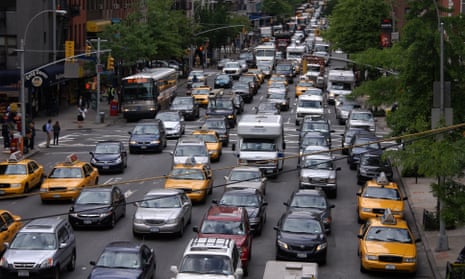New York City will be the first in the US to impose congestion pricing, charging drivers to enter the most crowded parts of Manhattan.
The plan was approved by the state legislature early on Monday morning as part of the state budget, after a crisis in the city’s subways brought to a head a decade-long fight over charging motorists in Manhattan.
Under the plan backed by Governor Andrew Cuomo, drivers will have to pay tolls to enter Manhattan south of 60th Street.
The plan is expected to raise $15bn for the Metropolitan Transportation Authority, which is struggling to modernize decades-old subway infrastructure and reduce rampant delays.
The amount of the toll has not been set, but a new board has been created to figure out the details. Past proposals have called for a charge of around $12 for cars and $25 for trucks, but the amount will vary based on day and time.
“This is a great victory for transit riders,” said Danny Pearlstein of the Riders Alliance, a pressure group.
“We have a signal system that dates to the 1930s. We have subway cars that date to the 60s. We have a subway system where a scant minority of stations are accessible to riders in wheelchairs and to people with strollers. The money will go a long way toward starting the work and delivering projects that we need done.”
Congestion pricing was proposed more than a decade ago by the then mayor, Michael Bloomberg, failing after a fierce political fight. But amid escalating complaints from transit riders fed up with bad service, Cuomo pushed for charges which have existed in cities like London for years but have never been tried in the US.
Mayor Bill de Blasio, who long objected to charging the small proportion of working-class New Yorkers who drive into Manhattan, endorsed the plan this year. A Democratic takeover of the state senate paved the way for it to pass.
Manhattan’s FDR Drive and West Side highway, which run up and down either side of the island, will be exempt from the charge, while people who live in the congestion zone and make less than $60,000 will get a tax credit for any tolls they pay. Other discounts will be decided by the new board. Passengers in taxis and for-hire cars already have to pay a congestion charge up to $2.75 in Manhattan.
The new fees will not go into effect until the end of 2020 at the earliest.
In the city on Monday, subway riders said they would welcome any improvement in problem-plagued service. But several doubted that relief was really on the way.
“The subway is terrible,” said Akim Bello, 28, who said he has to leave his home in Queens three hours in advance to get to work in Manhattan on the weekend, because of poor service. “I’m not seeing where this money is going at all. Every year they’re saying they’re working on improving, and I don’t see much of a difference.”
Pat Foye, the newly installed chairman of the MTA, acknowledged the transit authority has “lost credibility” with riders. “We’re talking about improved service for the millions of people who take subways, buses and commuter rails,” he said on Monday. “Make no mistake, this won’t solve all our problems.”
A majority of New York households do not own cars. Opponents of the congestion charge say it will hurt people from the outer boroughs who have poor transit options in their neighborhoods.
“You create in some ways a separate city unto itself below 60th Street in Manhattan. Why should my constituents have to pay to get in there?” said the Queens city councilman Barry Grodenchik. “It’s going to hurt the people who can least afford it.”
Rocky Karla, 60, a delivery service owner, said a new charge would force him to raise prices for his customers.
“They’re saying it’s going to help in lowering the congestion,” he said. “I don’t think so because everybody has to come here. They have to come here to make money, they come here for business, and they have no choice.”
In midtown Manhattan, traffic crawls at an average speed of 4.7mph.
Other US cities may look to New York’s plan for a congestion solution, but Mitchell Moss, the head of the Rudin Center for Transportation at New York University, said the city’s situation is unique.
“There is nothing as dense as Manhattan,” he said.
